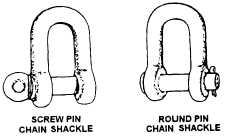Figure 13-27.—Anchor shackles.
Figure 13-28.—Chain shackles.
shackle with the screw pin on the dead end of the rope.
If placed on the running end, the movement of the rope
may loosen the pin.
Shackles are moused whenever there is a chance of
the shackle pin working loose and coming out because
of vibration. To mouse a shackle, simply take several
turns with seizing wire through the eye of the pin and
around the bow of the shackle. Figure 13-26 shows what
a properly moused shackle looks like.
FIBER LINE
Fiber line is commonly used to hoist and move
heavy loads. Fiber line is constructed similar to wire
rope. One difference is yarn. Yarn is used to make the
strand in place of wire. Another difference is fiber line
does not have a core.
TYPES OF FIBER LINE
The most common types of fiber line are manila,
sisal, hemp, cotton, nylon, and Kevlar. The character-
istics of these fiber lines are discussed below.
Manila
Manila is a strong fiber that comes from the leaf
stems of the stalk of the abaca plant, which belongs to
the banana family. The fibers vary in length from 1.2 to
4.5 meters in the natural state. The quality of the fiber
and its length give manila rope relatively high elasticity,
strength, and resistance to wear and deterioration. In
many instances, the manufacturer treats the rope with
chemicals to make it more mildew resistant, which
increases the quality of the rope. Manila rope is
generally the standard item of issue because of its
quality and relative strength.
Sisal
Sisal rope is made from two tropical plants that yield
a strong, valuable fiber. These plants, sisalana and
henequen, produce fibers 0.6 to 1.2 meters long with
sisalana producing the stronger fibers of the two plants.
Because of the greater strength of sisalana, these fibers
are used to make the rope known as sisal. Sisal rope is
about 80 percent as strong as high-quality manila rope
and can be easily obtained. It withstands exposure to
seawater very well and is often used for this reason.
Hemp
Hemp is a tall plant that provides useful fibers for
making rope and cloth. Cultivated in many parts of the
world, hemp was used extensively before the intro-
duction of manila. Its principal use now is in fittings,
such as ratline, marline and spun yarn. Since hemp
absorbs tar much better than the hard fibers, these
fittings are invariably tarred to make them water
resistant. Tarred hemp has about 80 percent of the
strength of untarred hemp. Of these tarred fittings,
marline is the standard item of issue.
Cotton
Cotton rope is a very smooth white rope that stands
much bending and running. Cotton is not widely used in
the Navy except in some cases for small lines.
Nylon
Nylon rope has a tensile strength that is nearly three
times that of manila rope. The advantage of using nylon
rope is that it is waterproof and has the ability to resume
normal length after being stretched and/or absorbing
shocks. It also resists abrasion, rot, decay, and fungus
When nylon rope is properly handled and
maintained, it should last more than five times longer
than manila line subjected to the same use. Nylon rope
is also lighter, more flexible, less bulky, and easier to
handle and store than manila line. When nylon rope is
13-13



